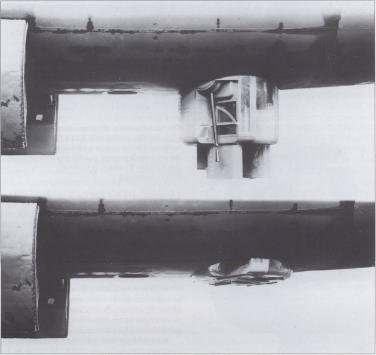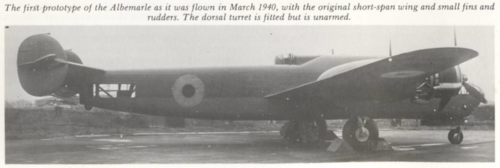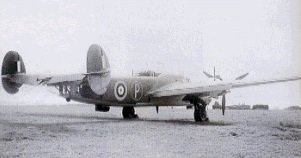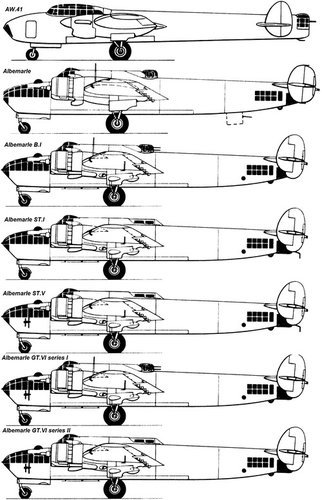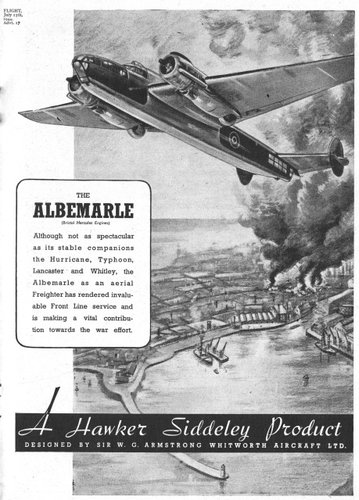Other than the Preston Green ventral turret were there any other manned ventral turrets planned? Several British bombers were planned with a ventral turret with 4x20mm cannon but I have never seen how these were to operate. Also I seem to remember hearing of a domed glazed ventral turret which could rotate 360 degrees but I cannot remember where.
You are using an out of date browser. It may not display this or other websites correctly.
You should upgrade or use an alternative browser.
You should upgrade or use an alternative browser.
British manned ventral turrets?
- Thread starter one13
- Start date
The only that springs to mind is the one fitted in the Handley Page Heyford - see http://www.aviastar.org/gallery/heyford.html
- Joined
- 22 April 2012
- Messages
- 2,318
- Reaction score
- 1,839
Fraser Nash FN64
Boulton Paul Type R
Bristols did a lot of work on 20mm turrets and Barbettes as did Boulton Paul. The latter designe but never finished a Hispano equipped dorsal turret and the unmanned Lancaster barrettes whilst the former did the B17 used on the Shackleton/Lincoln and an improved version after that.
Boulton Paul Type R
Bristols did a lot of work on 20mm turrets and Barbettes as did Boulton Paul. The latter designe but never finished a Hispano equipped dorsal turret and the unmanned Lancaster barrettes whilst the former did the B17 used on the Shackleton/Lincoln and an improved version after that.
- Joined
- 6 September 2006
- Messages
- 4,315
- Reaction score
- 7,468
Boulton Paul developed a few manned ventral turrets.
The retractable Type K with twin .303in MGs as used on the Halifax and Albemarle.
The Type R with a periscope sight.
The unbuilt Type U which was built to US standards with twin 0.50in MGs
There was another undesignated turret with the gunner lying on his side and armed with twin .303in, it too wasn't built.
The retractable Type K with twin .303in MGs as used on the Halifax and Albemarle.
The Type R with a periscope sight.
The unbuilt Type U which was built to US standards with twin 0.50in MGs
There was another undesignated turret with the gunner lying on his side and armed with twin .303in, it too wasn't built.
- Joined
- 21 May 2006
- Messages
- 2,709
- Reaction score
- 1,624
Early Whitleys and Wellingtons had an extendable ventral turret.
Thanks Dogsbody
I would love to see a photo of this
Regards
Pioneer
- Joined
- 6 November 2010
- Messages
- 4,227
- Reaction score
- 3,159
The second prototype Avro Manchester L7247 had a manned retractable ventral turret too.
Source: 'Avro Manchester - The legend behind the Lancaster' by Robert Kirby, Midland Publishing 1995
Buy it here, or anywhere else. It's a good read.
Source: 'Avro Manchester - The legend behind the Lancaster' by Robert Kirby, Midland Publishing 1995
Buy it here, or anywhere else. It's a good read.
Attachments
- Joined
- 31 July 2013
- Messages
- 546
- Reaction score
- 1,074
Here's a pic of a Lanc I with the ventral turret. In fact this particular aircraft was the first of the type to cross the Atlantic, being used by Victory Aircraft as a pattern for the Lanc X. Also although not a British built aircraft, were any of the early B-25 Mitchells supplied to the RAF still fitted with their ventral turrets? I also attach a pic of that setup together with a diagram of the gun positions for the B-25C/D. The ventral position was replaced by the waist gun positions due to the uncomfortable nature of the ventral turret!



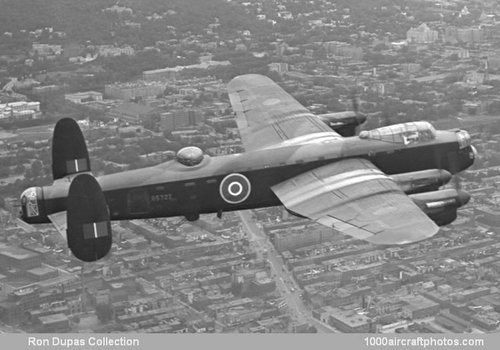
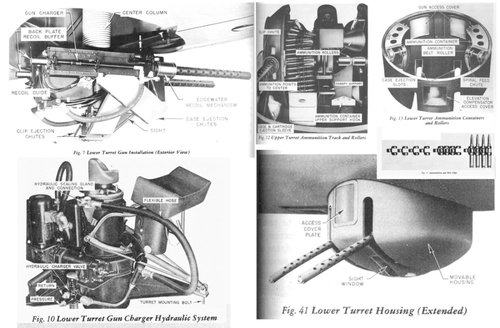
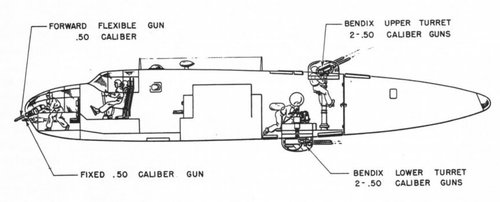
nuuumannn
Cannae be ar*ed changing my personal text
- Joined
- 21 October 2011
- Messages
- 276
- Reaction score
- 526
British ventral power turrets actually fitted to service aircraft:
Boulton Paul Type K Mk.I and II equipped with 2 x .303 Brownings, fitted to Handley Page Halifax Mk.I and IIs and Armstrong Whitworth Albemarle prototype only.
Bristol Beaufort Nose Rear Defence Turret fitted with a single .303 Browning fitted under the extreme nose.
Bristol Type B.13 armed with 2 x .303 Brownings, fitted to the Bristol Buckingham in rear facing gondola.
Nash & Thompson FN.17 fitted with 2 x .303 Brownings and mounted on Armstrong Whitworth Whitley Mks I, II, III and IV.
Nash & Thompson FN.21 and FN.21A fitted with 2 x .303 Brownings and arming Avro Manchester Mk.I.
Nash & Thompson FN.25 fitted with 2 x .303 Brownings arming Vickers Wellington Mk.Ia.
Nash & Thompson FN.64 fitted with 2 x .303 Brownings arming Avro Lancaster Mk.I and II.
There were experimental turrets designed by Boulton Paul, Bristol and Nash & Thompson, which were trial fitted only and did not enter service.
The Handley Page Heyford ventral gun emplacement, named the Dustbin for obvious reasons was not a powered turret, nor was the Preston Green Under Defence Mounting Mk.II fitted to Halifax Mk.III.
Boulton Paul Type K Mk.I and II equipped with 2 x .303 Brownings, fitted to Handley Page Halifax Mk.I and IIs and Armstrong Whitworth Albemarle prototype only.
Bristol Beaufort Nose Rear Defence Turret fitted with a single .303 Browning fitted under the extreme nose.
Bristol Type B.13 armed with 2 x .303 Brownings, fitted to the Bristol Buckingham in rear facing gondola.
Nash & Thompson FN.17 fitted with 2 x .303 Brownings and mounted on Armstrong Whitworth Whitley Mks I, II, III and IV.
Nash & Thompson FN.21 and FN.21A fitted with 2 x .303 Brownings and arming Avro Manchester Mk.I.
Nash & Thompson FN.25 fitted with 2 x .303 Brownings arming Vickers Wellington Mk.Ia.
Nash & Thompson FN.64 fitted with 2 x .303 Brownings arming Avro Lancaster Mk.I and II.
There were experimental turrets designed by Boulton Paul, Bristol and Nash & Thompson, which were trial fitted only and did not enter service.
The Handley Page Heyford ventral gun emplacement, named the Dustbin for obvious reasons was not a powered turret, nor was the Preston Green Under Defence Mounting Mk.II fitted to Halifax Mk.III.
Last edited:
nuuumannn
Cannae be ar*ed changing my personal text
- Joined
- 21 October 2011
- Messages
- 276
- Reaction score
- 526
although not a British built aircraft, were any of the early B-25 Mitchells supplied to the RAF still fitted with their ventral turrets?
Yes, they were. Mitchell Mk.Is and IIs were fitted with the Bendix turret as standard. Nice piccy here:
- Joined
- 19 October 2012
- Messages
- 1,917
- Reaction score
- 1,766
FN19 was installed on the prototype Stirling and would also intended for the Supermarine Type 317
nuuumannn
Cannae be ar*ed changing my personal text
- Joined
- 21 October 2011
- Messages
- 276
- Reaction score
- 526
FN19 was installed on the prototype Stirling and would also intended for the Supermarine Type 317
It was installed in the prototype Stirling only and was not fitted to service aircraft.
- Joined
- 19 October 2012
- Messages
- 1,917
- Reaction score
- 1,766
......which is what I said
- Joined
- 11 March 2012
- Messages
- 3,016
- Reaction score
- 2,693
Removing ventral turrets allowed paratroopers to drop from the bellies of converted bombers.
Whitley’s and Albemarles dropped early British paratroopers starting in 1940. The newly formed airborne forces were so desperate for airplanes, that they took anything available.Ventral turrets and tail/rear turrets were quickly removed from the first Whitley’s to arrive at RAF Ringway.
After a few experiments with jumping from the hole vacated by the rear turret, paratroopers switched to falling out the round hatch left by removing the ventral l turret.
Poor exit techniques often “rang the bell” ... er ... smacked the head against the rear lip of the hole. This drove drove invention of the “Sorbo” helmet, basically a donut of spongy rubber wrapped in cloth. This shock absorbing rubber ring was incorporated into the mid-war steel paratroopers’ helmets.
Whitley’s only dropped paratroopers in Italy and Bruneval. They were soon replaced by American C-46 Commandos and C-47 Dakotas with large, side cargo doors.
Whitleys and Albemarles soldiered on as glider tugs. In 1944, a few Albemarles dropped groups of (up to ten) Pathfinders just before the D-Day landings. Pathfinders’ primary task was marking landing fields in advance of the main body of paratroopers.
See John Greenacre’s book “Churchill’s Spearhead, the development of Britain’s Airborne Forces during World War II.”
Whitley’s and Albemarles dropped early British paratroopers starting in 1940. The newly formed airborne forces were so desperate for airplanes, that they took anything available.Ventral turrets and tail/rear turrets were quickly removed from the first Whitley’s to arrive at RAF Ringway.
After a few experiments with jumping from the hole vacated by the rear turret, paratroopers switched to falling out the round hatch left by removing the ventral l turret.
Poor exit techniques often “rang the bell” ... er ... smacked the head against the rear lip of the hole. This drove drove invention of the “Sorbo” helmet, basically a donut of spongy rubber wrapped in cloth. This shock absorbing rubber ring was incorporated into the mid-war steel paratroopers’ helmets.
Whitley’s only dropped paratroopers in Italy and Bruneval. They were soon replaced by American C-46 Commandos and C-47 Dakotas with large, side cargo doors.
Whitleys and Albemarles soldiered on as glider tugs. In 1944, a few Albemarles dropped groups of (up to ten) Pathfinders just before the D-Day landings. Pathfinders’ primary task was marking landing fields in advance of the main body of paratroopers.
See John Greenacre’s book “Churchill’s Spearhead, the development of Britain’s Airborne Forces during World War II.”
- Joined
- 9 October 2009
- Messages
- 19,908
- Reaction score
- 10,418
Whitley’s only dropped paratroopers in Italy and Bruneval.
They were occasionally still used for special operations after that, I believe.
- Joined
- 31 July 2013
- Messages
- 546
- Reaction score
- 1,074
A great friend of mine was Wing Commander James Blythe, who was both a teacher and my year head at school. He not only was one of the original first trainees at Ringway, but Jimmy also later became CO of No 1 PTS at Abingdon. During his time there he saw the formation of the Falcons Display Team, under Peter Hearn, whose two sons were also at school with me! Peter also eventually became head of No 1 PTS, which by then had moved to Brize Norton. Going back to the point, Jimmy told me he, himself rang the bell, on his first jump.Removing ventral turrets allowed paratroopers to drop from the bellies of converted bombers.
Whitley’s and Albemarles dropped early British paratroopers starting in 1940. The newly formed airborne forces were so desperate for airplanes, that they took anything available.Ventral turrets and tail/rear turrets were quickly removed from the first Whitley’s to arrive at RAF Ringway.
After a few experiments with jumping from the hole vacated by the rear turret, paratroopers switched to falling out the round hatch left by removing the ventral l turret.
Poor exit techniques often “rang the bell” ... er ... smacked the head against the rear lip of the hole. This drove drove invention of the “Sorbo” helmet, basically a donut of spongy rubber wrapped in cloth. This shock absorbing rubber ring was incorporated into the mid-war steel paratroopers’ helmets.
Whitley’s only dropped paratroopers in Italy and Bruneval. They were soon replaced by American C-46 Commandos and C-47 Dakotas with large, side cargo doors.
Whitleys and Albemarles soldiered on as glider tugs. In 1944, a few Albemarles dropped groups of (up to ten) Pathfinders just before the D-Day landings. Pathfinders’ primary task was marking landing fields in advance of the main body of paratroopers.
See John Greenacre’s book “Churchill’s Spearhead, the development of Britain’s Airborne Forces during World War II.”
- Joined
- 11 March 2012
- Messages
- 3,016
- Reaction score
- 2,693
F.N. 64 un-manned ventral turrets were fitted to a few early Lancaster’s but proved impractical in combat.
Granted, the gunner could sit comfortably inside the fuselage, but he only had a periscope 20 degrees wide and the turret traversed too slow to track Me 109. F.N. turrets were removed from most operational Lancaster’s to be replaced by HS radar.
When the Luftwaffe started equipping night fighters with shrage musik, upward-firing guns, some Lancaster squadrons jury-rigged machine guns in the hole vacated by F.N. turrets.
To be practical, F.N.. turrets really needed dual-mode periscopes with a hemispherical scan mode and a 20 degree firing mode. I doubt if that was possible with 1940-vintage optics. They also needed to switch modes in the blink of an eye. Ideally, they would have “zoom Lenses to gradually switch between the two modes.
Granted, the gunner could sit comfortably inside the fuselage, but he only had a periscope 20 degrees wide and the turret traversed too slow to track Me 109. F.N. turrets were removed from most operational Lancaster’s to be replaced by HS radar.
When the Luftwaffe started equipping night fighters with shrage musik, upward-firing guns, some Lancaster squadrons jury-rigged machine guns in the hole vacated by F.N. turrets.
To be practical, F.N.. turrets really needed dual-mode periscopes with a hemispherical scan mode and a 20 degree firing mode. I doubt if that was possible with 1940-vintage optics. They also needed to switch modes in the blink of an eye. Ideally, they would have “zoom Lenses to gradually switch between the two modes.
- Joined
- 21 December 2006
- Messages
- 1,132
- Reaction score
- 614
Are there any pictures of the Albermarle with a ventral turret?
nuuumannn
Cannae be ar*ed changing my personal text
- Joined
- 21 October 2011
- Messages
- 276
- Reaction score
- 526
Indeed you did, Schneiderman, I was pointing out that it never entered service is all, in case anyone thought I'd left it off the list.......which is what I said
nuuumannn
Cannae be ar*ed changing my personal text
- Joined
- 21 October 2011
- Messages
- 276
- Reaction score
- 526
FN.64 un-manned ventral turrets were fitted to a few early Lancaster’s but proved impractical in combat.
Well, they were manned, but the operator didn't sit in the turret - they weren't remotely operated; the gunner sat over the turret in the fuselage.
I have never seen a photo of the turret installed in an Albemarle, Harrier. The Armstrong Whitworth Putnam book states the Albemarle was to be fitted with an unpowered ventral turret, but the BP K Type turret was definitely powered and was intended on installation in Albemarles. Was one actually fitted, I wonder? Interestingly enough, the glazing around the Albemarle's tail was for a gunnery controller's position, who would spot incoming aircraft and call out to the turret operators. Here's a good image of a rear view of the type, but no ventral turret visible.Are there any pictures of the Albermarle with a ventral turret?
- Joined
- 6 November 2010
- Messages
- 4,227
- Reaction score
- 3,159
From WW2 Aircraft Fact Files - RAF Bombers Part 1 by William Green and David Swanborough, Macdonald and Jane's (Pilot Press) 1979.Are there any pictures of the Albemarle with a ventral turret?
Not the clearest of images, might actually be retouched.
Attachments
Last edited:
- Joined
- 21 December 2006
- Messages
- 1,132
- Reaction score
- 614
Thanks to both of you.
Seems a very small turret, with no footwells etc., and may indeed just be a dummy for trials or retouched in.
Gunnery controller, with no gun of their own, seems odd. I always wondered why all the transparencies were in the tail.
Thanks again
Seems a very small turret, with no footwells etc., and may indeed just be a dummy for trials or retouched in.
Gunnery controller, with no gun of their own, seems odd. I always wondered why all the transparencies were in the tail.
Thanks again
nuuumannn
Cannae be ar*ed changing my personal text
- Joined
- 21 October 2011
- Messages
- 276
- Reaction score
- 526
You could be right. The turret would not have been a rectangular box like that, that's for sure. Regarding the gunnery controller role, the original premise was to avoid placing weighty gun turrets in the extreme nose and tail, so turrets were placed amidships with reaching arcs, the upper one, the aftermost part of the upper fuselage around the turret was intended to fold downwards to increase the arc of fire, like the fairings on the Defiant. The Albemarle's crew was originally intended on being five, as stipulated in the original specification (17/38, amended to 18/38), but I have seen it written as six - perhaps a separate navigator was carried; two pilots, one of which was a navigator and bomb aimer, two gunners and a W/T operator, who, presumably acted as gunnery controller since the nav position was in the nose. Kinda makes sense when attempting to control weight growth. According to Ray Williams in an article in Air Enthusiast, only the first 32 were so configured. For a stop-gap aircraft, the Albemarle wasn't a bad design, in fact it was well thought out and practicable in execution.Not the clearest of images, might actually be retouched.
- Joined
- 26 May 2011
- Messages
- 2,111
- Reaction score
- 2,692
From RiggerBob - When the Luftwaffe started equipping night fighters with shrage musik, upward-firing guns, some Lancaster squadrons jury-rigged machine guns in the hole vacated by F.N. turrets.
When did the RAF discover that the Nachtjagers were using Schrage Musik and what it actually was? I've read various pieces about Scarecrow flak shells etc etc to explain the exploding bombers.
Chris
When did the RAF discover that the Nachtjagers were using Schrage Musik and what it actually was? I've read various pieces about Scarecrow flak shells etc etc to explain the exploding bombers.
Chris
- Joined
- 6 November 2010
- Messages
- 4,227
- Reaction score
- 3,159
Green and Swanborough about the Albemarle:
<edit> As mentioned by nuuumannn in reply #26, Air Enthusiast #39 has an article by Ray Williams about the Albemarle.... testing did not resume until 20 april 1941 when the second prototype made its first flight, with the increased-span wing and ventral armament fitted.
The second prototype [...] proved to be the only Albemarle to be fitted with a two-gun ventral power-operated turret.
Last edited:
- Joined
- 31 July 2013
- Messages
- 546
- Reaction score
- 1,074
- Joined
- 21 December 2006
- Messages
- 1,132
- Reaction score
- 614
Another good pic. Thanks.
I also stumbled on the attached picture at https://www.the-blueprints.com/blue...armstrong_whitworth_aw_41_albemarle-91144.jpg
I find it hard to believe they would have someone in or on the under turret who took direction from a colleague looking out of the tail a few feet away. Seems like lots of potential for confusion. Perhaps the under turret was to be controlled from the tail, maybe like the FN.64 but with no periscope and 'long handles'?
Also, the original AW.41 design with a tail turret looks better than what emerged IMHO. A bit like a Dornier-ish Avro Manchester.
My interest in the Albemarle stems from driving past the old A W Hawksley factory in Gloucester quite often. Still an active factory, making textiles. Not that even the original makers of the Albemarle seemed very proud of it. The attached ad from Hawker Siddeley damns it with faint praise.
I also stumbled on the attached picture at https://www.the-blueprints.com/blue...armstrong_whitworth_aw_41_albemarle-91144.jpg
I find it hard to believe they would have someone in or on the under turret who took direction from a colleague looking out of the tail a few feet away. Seems like lots of potential for confusion. Perhaps the under turret was to be controlled from the tail, maybe like the FN.64 but with no periscope and 'long handles'?
Also, the original AW.41 design with a tail turret looks better than what emerged IMHO. A bit like a Dornier-ish Avro Manchester.
My interest in the Albemarle stems from driving past the old A W Hawksley factory in Gloucester quite often. Still an active factory, making textiles. Not that even the original makers of the Albemarle seemed very proud of it. The attached ad from Hawker Siddeley damns it with faint praise.
Attachments
- Joined
- 11 March 2012
- Messages
- 3,016
- Reaction score
- 2,693
My impression is that Albemarle was a gap-filler in case one of the other medium bombers failed. The numbers look roughly similar to early B-25s, but we are comparing Albemarle first flight numbers with mature B-25 production.
Albemarle arrived on the scene around the same time as North American Aviation ramped up B-25 Mitchell production. The RAF and RCAF flew dozens/hundreds of Mitchell’s as it proved to be one of the best medium bombers of WW2.
By late war, the USAAF had so many Mitchells that they used them to train bomber crews ... skip those silly Becchcraft 18s!
RCAF continued flying their Mitchells well into the 1950s as trainers.
Did I ever tell you about the week I spent test-dropping parachutes from a B-25? The tail gunner has the best view.
Albemarle arrived on the scene around the same time as North American Aviation ramped up B-25 Mitchell production. The RAF and RCAF flew dozens/hundreds of Mitchell’s as it proved to be one of the best medium bombers of WW2.
By late war, the USAAF had so many Mitchells that they used them to train bomber crews ... skip those silly Becchcraft 18s!
RCAF continued flying their Mitchells well into the 1950s as trainers.
Did I ever tell you about the week I spent test-dropping parachutes from a B-25? The tail gunner has the best view.
- Joined
- 31 July 2013
- Messages
- 546
- Reaction score
- 1,074
Harrier, I have two links with Albemarle production as members of my family worked at Hawkesley's, and later Gloster on my dads side. On my mum's side of the family, we had members building the noses at the MG factory at Abingdon.
- Joined
- 22 April 2012
- Messages
- 2,318
- Reaction score
- 1,839
I always assumed that the heavy glazing and supposed observer in the tail of the Albemarle was an acceptance of the appalling situational awareness available to the ventral gunner through his periscope, the observer at least being able to communicate the direction of incoming aircraft over a 180+ degree angle (note the glazing in the rear fuselage side as well as the tail). That said, I can imagine it being frustrating to be that observer and not have at least a K-gun to shoot back with given the sense of vulnerability that would have come with his location in the aircraft.
- Joined
- 25 July 2007
- Messages
- 3,873
- Reaction score
- 3,171
I always assumed that the heavy glazing and supposed observer in the tail of the Albemarle was an acceptance of the appalling situational awareness available to the ventral gunner through his periscope, the observer at least being able to communicate the direction of incoming aircraft over a 180+ degree angle (note the glazing in the rear fuselage side as well as the tail). That said, I can imagine it being frustrating to be that observer and not have at least a K-gun to shoot back with given the sense of vulnerability that would have come with his location in the aircraft.
Exactly. Green and Swanborough described that role as a "fire-controller". Once the belly turret was eliminated, one wonders why the fire-controller position was retained? Or, as you say, arm the tail position.
RAF Bombers Part 1, MacDonald and Janes, London, 1979, page 17
- Joined
- 21 December 2006
- Messages
- 1,132
- Reaction score
- 614
The Jet Age Museum is very good at covering the local industry, although Hawkesley's seems to be little represented. The factory made houses and jet engines too.Harrier, I have two links with Albemarle production as members of my family worked at Hawkesley's, and later Gloster on my dads side. On my mum's side of the family, we had members building the noses at the MG factory at Abingdon.
- Joined
- 21 December 2006
- Messages
- 1,132
- Reaction score
- 614
Still seems a very odd idea. Why not move the turret near the side windows, or vice versa? "Focke Wulfe at 2 o'clock" "You called me a what mate?". Also adds an extra crew member.I always assumed that the heavy glazing and supposed observer in the tail of the Albemarle was an acceptance of the appalling situational awareness available to the ventral gunner through his periscope, the observer at least being able to communicate the direction of incoming aircraft over a 180+ degree angle (note the glazing in the rear fuselage side as well as the tail). That said, I can imagine it being frustrating to be that observer and not have at least a K-gun to shoot back with given the sense of vulnerability that would have come with his location in the aircraft.
Exactly. Green and Swanborough described that role as a "fire-controller". Once the belly turret was eliminated, one wonders why the fire-controller position was retained? Or, as you say, arm the tail position.
RAF Bombers Part 1, MacDonald and Janes, London, 1979, page 17
In any case, proper cutaway of the original version would be good.
Last edited:
- Joined
- 31 July 2013
- Messages
- 546
- Reaction score
- 1,074
Don't worry, with my connections I've been a member for a good deal of years!The Jet Age Museum is very good at covering the local industry, although Hawkesley's seems to be little represented. The factory made houses and jet engines too.Harrier, I have two links with Albemarle production as members of my family worked at Hawkesley's, and later Gloster on my dads side. On my mum's side of the family, we had members building the noses at the MG factory at Abingdon.
I don't know. But, if memory serves, the famous physicist Freeman Dyson discusses this in his book Disturbing the Universe. Dyson was serving in an RAF Operational Research organization that deduced the introduction of upward firing weapons from statistical studies of loss rates. But higher authority rejected their conclusions. I always thought it odd that the RAF could have been so slow to recognize the possibility, given the RAF's widespread use of upward firing guns in WW1.From RiggerBob - When the Luftwaffe started equipping night fighters with shrage musik, upward-firing guns, some Lancaster squadrons jury-rigged machine guns in the hole vacated by F.N. turrets.
When did the RAF discover that the Nachtjagers were using Schrage Musik and what it actually was? I've read various pieces about Scarecrow flak shells etc etc to explain the exploding bombers.
Chris
- Joined
- 21 December 2006
- Messages
- 1,132
- Reaction score
- 614
Just because the study is convincing does not mean it will change pre-determined minds!I don't know. But, if memory serves, the famous physicist Freeman Dyson discusses this in his book Disturbing the Universe. Dyson was serving in an RAF Operational Research organization that deduced the introduction of upward firing weapons from statistical studies of loss rates. But higher authority rejected their conclusions. I always thought it odd that the RAF could have been so slow to recognize the possibility, given the RAF's widespread use of upward firing guns in WW1.From RiggerBob - When the Luftwaffe started equipping night fighters with shrage musik, upward-firing guns, some Lancaster squadrons jury-rigged machine guns in the hole vacated by F.N. turrets.
When did the RAF discover that the Nachtjagers were using Schrage Musik and what it actually was? I've read various pieces about Scarecrow flak shells etc etc to explain the exploding bombers.
Chris
Freeman Dyson was very droll on hypersonics. 'It will work, but only with a negative payload'.
Dyson died only a couple of weeks ago.Freeman Dyson was very droll on hypersonics. 'It will work, but only with a negative payload'.
Similar threads
-
-
W
-
Heinkel 177 A7 R2 - an alternate version
- Started by airman
- Replies: 7
-
-
Looking for info on 'Turreted' prototype of French AMX 105 / Mk.61 SPG
- Started by Pioneer
- Replies: 4



